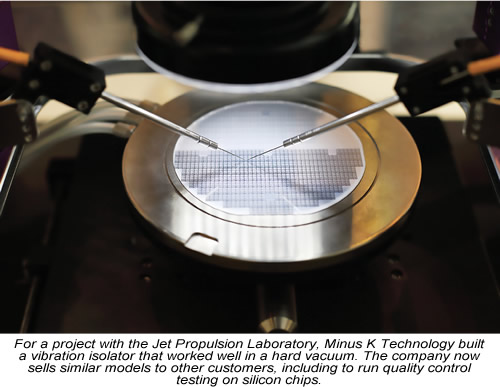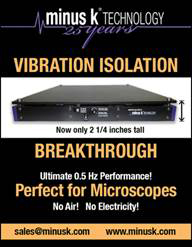|
|
Newsletter May 2019
Anybody who has ever tried to hold a camera steady for a long
exposure in low light knows exactly what inevitably happens: the camera shakes,
and the image blurs. The same can happen with images from telescopes or any
other long-range image. In fact, for some very sensitive optics, even ordinary
ground vibrations can be enough to throw off the results.
Thats why,
explains Serge Dubovitsky, instrument system engineer at the Jet Propulsion
Laboratory (JPL), NASA often needs a tool called a vibration isolator. These
work in a few different ways but essentially create a more stable platform
where external vibrations wont interfere with sensitive
measurements..
Dubovitsky often works on optics, including systems of
mirrors for observational missions like telescopes. The mirrors reflect light
in different wavelengths, concentrating it into an image that can be analyzed
by other instruments. But before these optics are installed, they have to be
tested to ensure they perform as intended.
For optics that operate in
roughly visible wavelengths, says Dubovitsky, any motion on the scale of one
micron [that is, one-millionth of a meter], or in some cases even much less
than that, disturbs the image quality.

Optics testing is also often done in a vacuum, with
ramifications for vibration isolators. Vacuum is important in verifying optics,
because air interferes with light. If you are aiming at space applications, on
the ground you need vacuum, Dubovitsky explains. Even when working with optics
that will remain on the ground, a vacuum can be helpful for testing.
More...
Related: Spacecraft Vibration
Isolation On the Ground isolation...
Related: Vacuum Chamber Vibration
Isolation...
| |

 |
The
LC-4 is an ultra
compact, low-frequency negative-stiffness isolator. It comes in two
configurations, our low horizontal frequency performance of 1.5 Hz or our ultra
low horizontal frequency performance of 0.5 Hz. Both configurations offer our
signature 0.5 Hz vertical natural frequency.
This low frequency
vibration isolator is for weight loads from 15 to 130 lbs. and 1/2 Hz
performance vertical and horizontal.
LC-4 isolators can be
combined into multi isolator systems to support heavier payloads while taking
up very little room themselves. The isolators are passive, manually-adjustable
and require no air or electricity.
More...
- Vertical natural frequency of 1/2 Hz or less can be achieved over
the entire load range.
- Horizontal natural frequency is load dependent. 1 1/2 Hz (low
horiz. freq.) or 1/2 Hz (ultra low horiz. freq.) or less natural frequencies
can be achieved at or near the nominal load.
- See
performance for a
typical transmissibility curve with 1/2 Hz natural frequency.
Pricing & specs for
LC-4
|
Vibration News &
Articles
Previous
Features:
Cryostat Vibration
Isolation
Nanoindentation & Micro Hardness
Testing
Vibration Isolation
Ultra-Low Frequency Vibration
Isolation Stabilizes Scanning Tunneling Microscopy
Neuronal Research into Animal
Learning, Memory Neuronal Research,
Vibration Isolation Problem &
Solution
Sunken Treasure Surrounding The
Coldest Cubic Meter In The Universe
Supported by Minus K Vibration
Isolators
Lithium Batteries: Superionic Solid
Electrolytes for Next-Generation
Spacecraft Vibration Isolation On the
Ground
Behavior of a Single Molecule-UCLA's
California NanoSystems Institute
Cleanroom Precision Vibration
Isolation
Negative-stiffness vibration
isolation is utilized to provide ultra-stability for multi-disciplined,
nano-level research at UCLA's California NanoSystems
Institute.
NASA/JWST Update: Custom James Webb
Space Telescope Vibration Isolators Working Well
Audiophile Interests: The Doehmann
Helix 1 Turntable
2018 Winners | Minus K Technology
Educational Giveaway to U.S. Colleges and Universities
|
|

 |
|
|
